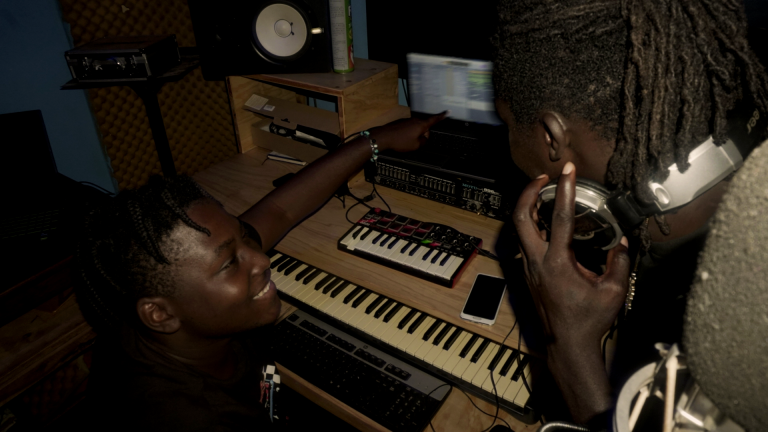Music
Music is an integral part of the culture and identity of Uganda, a landlocked country in East Africa with a diverse population of over 40 million people. The history of music in Uganda can be traced back to the pre-colonial era when different ethnic groups developed their own musical traditions, instruments, and styles. Some of the most prominent musical genres in Uganda include kadongo kamu, kidandali, bakisimba, and afrobeat.
Kadongo Kamu, which means “one guitar” in Luganda, is a genre of storytelling music that emerged in the 1950s and 1960s. It is characterized by a solo singer who accompanies himself or herself with an acoustic guitar and sings about social issues, politics, love, and morality. Kadongo kamu was popularized by artists such as Fred Masagazi, Christopher Sebaduka, and Elly Wamala.

Kidandali, which means “the beat” in Luganda, is a genre of contemporary dance music that emerged in the 1990s and 2000s. It is influenced by various musical styles from Africa and beyond, such as soukous, zouk, reggae, hip hop, and r&b. Kidandali is characterized by a fast tempo, catchy melodies, and electronic beats. Kidandali was popularized by artists such as Jose Chameleone, Bebe Cool, Bobi Wine, and Juliana Kanyomozi.
Bakisimba, which means “to jump” in Luganda, is a genre of traditional dance music that originated from the Buganda kingdom. It is performed by a group of drummers who play different types of drums, such as engalabi (long drum), empunyi (double-headed drum), and namunjoloba (small drum). Bakisimba is characterized by a complex rhythm, syncopation, and polyphony. Bakisimba is often accompanied by other instruments such as endere (flute), endigidi (fiddle), and akadinda (xylophone).
Afrobeat, which means “African beat” in English, is a genre of fusion music that emerged in the 1970s and 1980s. It is influenced by various musical styles from Africa and the diaspora, such as highlife, jazz, funk, soul, and calypso. Afrobeat is characterized by a groove-based rhythm, horn sections, call-and-response vocals, and political lyrics. Afrobeat was popularized by artists such as Fela Kuti from Nigeria and Geoffrey Oryema from Uganda.
The history of music in Uganda is rich and diverse, reflecting the cultural diversity and creativity of the Ugandan people. Music has played an essential role in shaping the social and political landscape of Uganda, as well as expressing the hopes and aspirations of its people. Music continues to evolve and innovate in Uganda today, as new genres emerge and old ones are reinterpreted.
Music is a powerful form of expression that can inspire, heal, and connect people. In Uganda, music is also a creative industry that provides opportunities for young artists to showcase their talents and earn a living. In this blog post, I will explore some of the ways that music is creative in Uganda, and how it reflects the culture, history, and diversity of the country.
One of the most creative aspects of music in Uganda is the fusion of traditional and modern elements. Many Ugandan musicians draw inspiration from their ethnic roots, using local languages, instruments, and rhythms to create unique sounds. For example, Eddy Kenzo, one of the most popular artists in Uganda, incorporates elements of Afrobeat, dancehall, and reggae into his songs, while also singing in Luganda, Swahili, and English. His hit song “Sitya Loss” (meaning “I’m not afraid”) features children dancing in the streets of Kampala, showcasing their joy and resilience.
Another way that music is creative in Uganda is the use of technology and social media to produce and distribute music. With limited access to formal recording studios and labels, many Ugandan musicians rely on their own devices and platforms to create and share their music. For example, Bobi Wine, a musician turned politician, uses his smartphone to record songs and videos that address social and political issues in Uganda. He then uploads them to YouTube, Facebook, and Twitter, reaching millions of followers and supporters.
Music is also creative in Uganda because it fosters collaboration and community among artists and fans. Music festivals, concerts, and competitions are common events that bring people together to celebrate and enjoy music. For example, Nyege Nyege Festival is an annual event that showcases diverse musical genres from Uganda and other African countries, as well as from Europe, Asia, and America. The festival attracts thousands of attendees who camp at the Nile Discovery Beach in Jinja for four days of non-stop music and dancing.
In conclusion, music is a creative industry in Uganda that reflects the rich and diverse culture of the country. Music is a way for Ugandan artists to express themselves, inspire others, and make a difference in their society. Music is also a way for Ugandan fans to connect with each other, support their favorite artists, and have fun.
HOW MUSIC HAS INFLUENCED UGANDA’S CULTURE
Music is not only a form of entertainment, but also a powerful tool for cultural expression and social change in Uganda, a landlocked country in East Africa with a diverse population of over 40 million people. The influence of music on Uganda’s culture can be seen in various aspects, such as language, identity, religion, and politics.
Language is one of the most obvious ways that music has influenced Uganda’s culture. Uganda has over 40 languages spoken by different ethnic groups, and music has helped to preserve and promote these languages. For example, kadongo kamu, a genre of storytelling music that emerged in the 1950s and 1960s, uses Luganda, the language of the largest ethnic group in Uganda, the Baganda. Kadongo kamu singers use Luganda to narrate stories about social issues, politics, love, and morality. Kadongo kamu has helped to popularize Luganda as a national language and a medium of communication among different ethnic groups.
Identity is another aspect that music has influenced Uganda’s culture. Music has helped to create and celebrate a sense of belonging and pride among different ethnic groups, as well as a sense of unity and diversity among Ugandans. For example, bakisimba, a genre of traditional dance music that originated from the Buganda kingdom, showcases the cultural heritage and values of the Baganda people. Bakisimba performers wear traditional costumes and play traditional instruments, such as drums, flutes, fiddles, and xylophones. Bakisimba has helped to preserve and display the cultural identity of the Baganda people, as well as to share it with other ethnic groups.
Religion is another aspect that music has influenced Uganda’s culture. Music has helped to spread and express religious beliefs and practices among different faiths, such as Christianity, Islam, and traditional religions. For example, afrobeat, a genre of fusion music that emerged in the 1970s and 1980s, incorporates elements of African spirituality and cosmology. Afrobeat singers use music to convey messages about social justice, human rights, and environmental issues. Afrobeat has helped to raise awareness and inspire action among Ugandans of different religious backgrounds.







